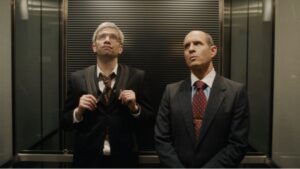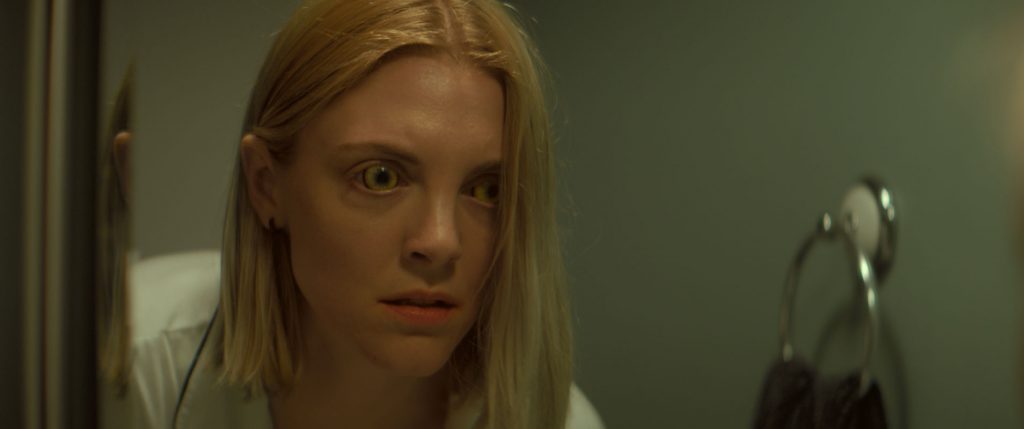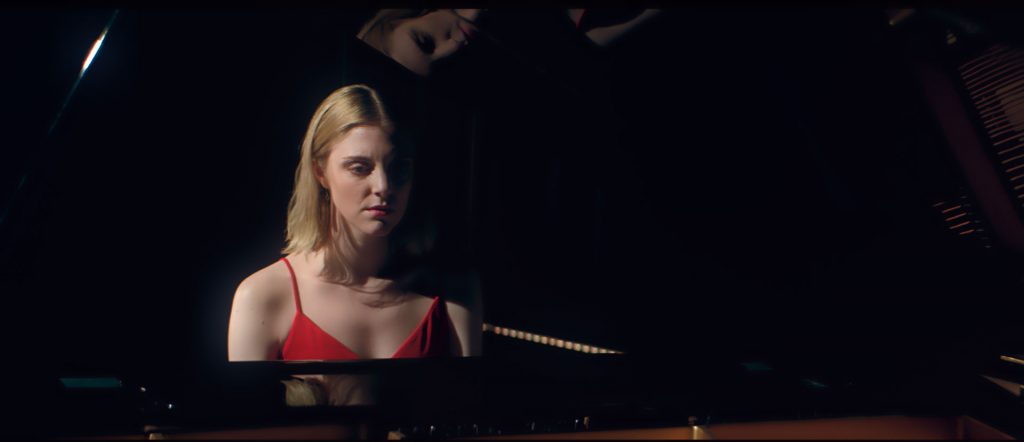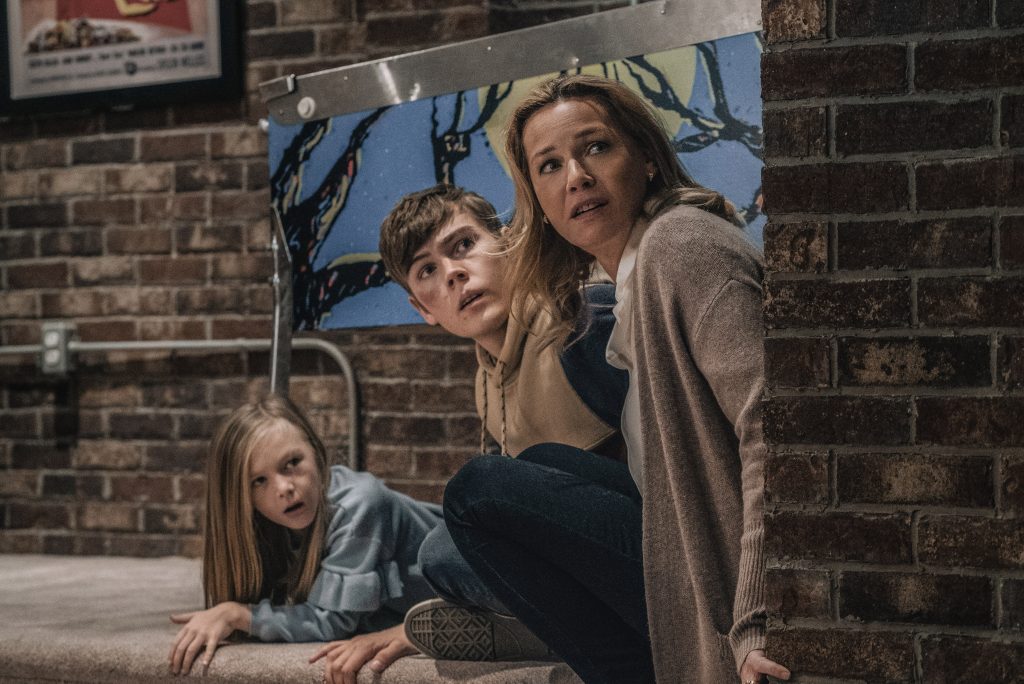April 17, 2024
by Carla Hay
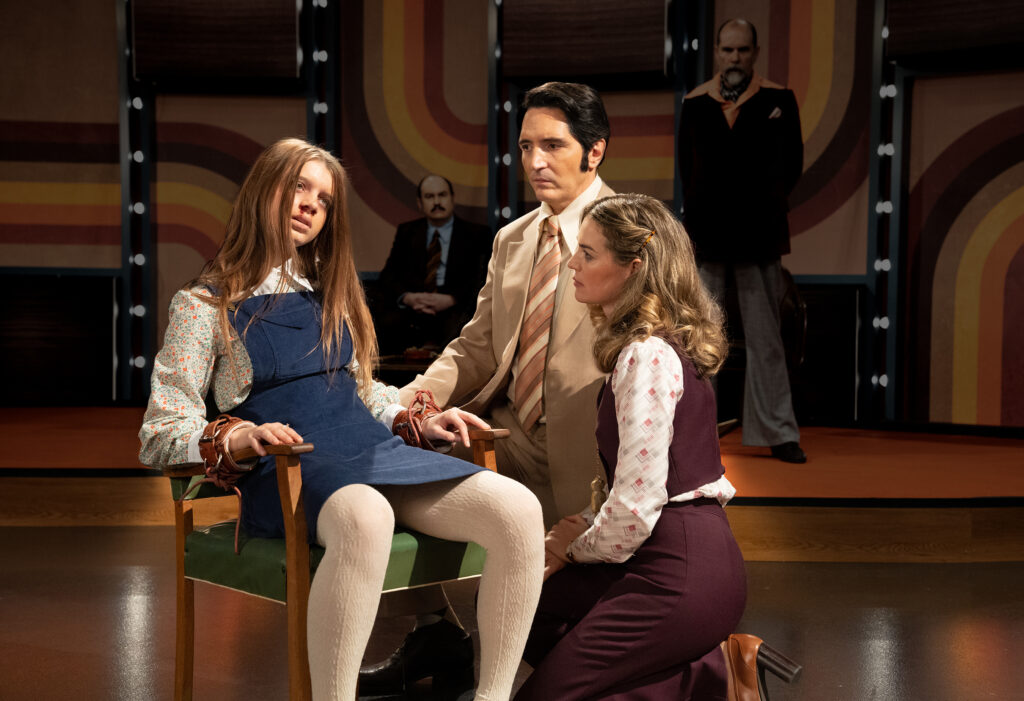
Directed by Cameron Cairnes and Colin Cairnes
Culture Representation: Taking place primarily during a “found footage” tape made in New York City, on October 31, 1977, the horror film “Late Night With the Devil” features a predominantly white cast of characters (with a few black people) representing the working-class, middle-class and wealthy.
Culture Clash: A late-night talk show host, who is desperate to boost his ratings, does a live seance on his show to summon the devil that reportedly possesses a 13-year-old girl.
Culture Audience: “Late Night With the Devil” will appeal primarily to people who are fans of star David Dastmalchian and well-made supernatural horror movies taking place in the 1970s.
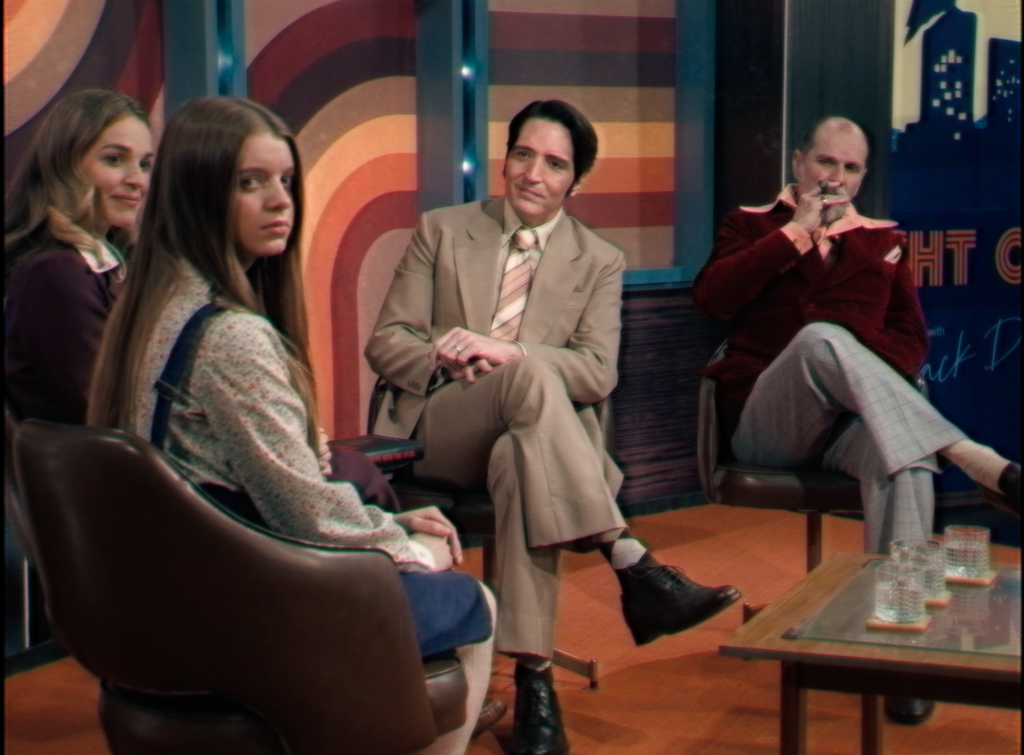
“Late Night With the Devil” hooks the senses with sinister suspense that might give nightmares to some viewers. This “found footage” horror flick taking place in 1977 shows parallels between devil possession and ruthless ambition. It’s an impressively made original horror movie that is an instant classic.
Written and directed by Australian brothers Cameron Cairnes and Colin Cairnes, “Late Night With the Devil” takes place in New York City, but was actually filmed in Melbourne, Australia. The movie had its world premiere at the 2023 SXSW Film and TV Festival. “Late Night With the Devil” does a superb job of recreating the late 1970s in every way, such as the production design, cinematography, costume design, makeup and hairstyling.
“Late Night With the Devil” begins with a voiceover narrator (Michael Ironside) with a fairly extensive backstory (shown in a montage) about the late-night talk/variety show host at the center of the movie. Jack Delroy (played by David Dastmalchian) was a popular radio host in Chicago when he was chosen to host and produce a national TV talk show called “Night Owls With Jack Delroy” (based in New York City) on the fictional UBC network. The first episode of “Night Owls With Jack Delroy” was on April 4, 1971.
Over the years, “Night Owls With Jack Delroy” had mediocre success, with the show always coming in second place to “The Tonight Show Starring Johnny Carson.” Johnny Carson had A-list celebrity guests. The guests on “Night Owls With Jack Delroy” were considered less than A-list, often with tabloid-like fame. Still, Jack earned enough respect in the industry to get an Emmy nomination for the show.
Jack is a member of all-male private club called The Grove, whose members are influential and powerful. The Grove’s secretive activities have been the subject of a lot of speculation. In November 1972, UBC owner Walter Bedford (played by John O’May) signed Jack to a five-year deal for Jack to continue to host and produce “Night Owls With Jack Delroy,” a show that is filmed before a live studio audience.
Jack’s personal life was also going fairly well: He married an actress named Madeleine Piper (played by Georgina Haig), who is described as Jack’s “muse and confidante.” Jack and Madeleine became known as a well-liked “power couple.” However, tragedy struck when Madeleine (a non-smoker) was diagnosed with terminal lung cancer. In October 1976, she did an emotional interview on “Night Owls With Jack Delroy.” It was the highest-rated episode in the show’s history. Madeleine died soon after filming this episode.
After Madeleine died, Jack took a hiatus and “disappeared” for about a month. He returned to doing the show in December 1976. However, the show’s ratings went on a downward spiral. By the time “Night Owls With Jack Delroy” did its Halloween episode on October 31, 1977, Jack’s contract was up for renewal (or cancellation), and he was feeling enormous pressure. Jack and his fast-talking and ambitious producer Leo Fiske (played by Josh Quong Tart) were desperate to boost the show’s ratings, so they planned a Halloween episode that they wanted to get a lot of publicity.
Things went horribly wrong, of course. The rest of “Late Night With the Devil” shows the master tape from this episode, as well as previously unreleased footage. The show’s guests on this fateful episode were a famous self-proclaimed psychic named Christou (played by Fayssal Bazzi); Carmichael Haig (played by Ian Bliss), a former magician who became world-renowned skeptic of all things supernatural; “Conversations With the Devil” non-fiction book author Dr. June Ross-Mitchell (played by Laura Gordon); the book’s subject, a 13-year-old girl named Lilly (played by Ingrid Torelli), who was said to be possessed by the devil; and jazz singer Cleo James (played by Nicole Chapman), who actually never performed in the episode, due to all the chaos that ensued.
in the production notes for “Late Night With the Devil,” Cameron Cairnes and Colin Cairnes both say that Australia’s “The Don Lane Show” (which was on the air from 1975 to 1983) was a big inspiration for the concept of this movie. The character of Carmichael was inspired by the real-life James Randi, whose magician name was the Amazing Randi. And the character Lilly could be seen as inspired by Linda Blair’s Regan MacNeil character in the 1973 Oscar-winning horror classic “The Exorcist.” In “Late Night With the Devil,” Lilly is the only survivor of a cult that was ordered by cult leader Szandor D’Abo (played by Steve Mouzakis) to set themselves on fire.
Cameron Cairnes and Colin Cairnes also had experience working in TV studios and saw firsthand the intense stress that workers can experience when filming episodes. That’s why the “Late Night With the Devil” scenes (especially those take place during commercial breaks) are convincing and why the movie is so effective in showing an increasingly tension-filled environment.
After Madeleine died, Jack took a hiatus and “disappeared” for about a month. He returned to doing the show in December 1976. However, the show’s ratings went on a downward spiral. By the time “Night Owls With Jack Delroy” did its Halloween episode on October 31, 1977, Jack’s contract was up for renewal (or cancellation), and he was feeling enormous pressure. Jack and his fast-talking and ambitious producer Leo Fiske (played by Josh Quong Tart) were desperate to boost the show’s ratings, so they planned a Halloween episode that they wanted to get a lot of publicity.
“Night Owls With Jack Delroy” has an amiable band leader named Gus McConnell (played by Rhys Auteri), who is like many band leaders on late-night talk shows: He’s there to be a sidekick who laughs at the host’s jokes. As things spiral out of control, Gus’ conscience starts to bother him about decisions that are made to increase the show’s TV audience. When Gus expresses his concerns, the response he gets is entirely realistic in the cutthroat world of television. Subordinates are often told that if they don’t do what they’re told, they’ll be fired, and there are plenty of people who are ready to replace them.
The screenplay and direction for “Late Night With the Devil” expertly build the ominous tension throughout the story. The movie stumbles during one particular gruesome scene where the in-studio audience members stay, despite the horror they just witnessed. In real life, most people in this type of audience would leave the studio in fear or disgust. It’s a minor but noticeable flaw in the otherwise realistic-looking way that the audience is portrayed in the movie. And to be clear: “Late Night With the Devil” gets very graphic and does not leave a lot of the horror up to the imagination.
Dastmalchian and Torelli give the movie’s standout performances. As Jack, Dastmalchian has an uneasy desperation that becomes increasingly dangerous as he pushes the boundaries of what’s acceptable to put on television. Torelli does an excellent job of balancing the “innocent-looking” and “demonic” sides to Lilly, the mysterious girl who never seems entirely “normal.” Thanks to horrific scenarios and a knockout ending, “Late Night With the Devil” is a memorably disturbing scary movie. Some viewers might never look at TV talk shows in the same way again.
IFC Films released “Late Night With the Devil” in U.S. cinemas on March 22, 2024. Shudder will premiere the movie on April 19, 2024.

